August 2019
Notes from President Dave
Greetings to All!!
July was an active month at the shop. Attendance was good at the Tuesday and Saturday gatherings.
Since work was going on at most stations at every meeting, it became obvious that another workstation was needed. Dee Haynes, who coordinates the coil winding operation, started a project to relocate the coil winding department and equipment to the basement and make room for a new workstation. The relocation project is now about 95% complete. Dee also built the table, shelves and cabinets for the new shop workstation. All that remains is to gather the necessary equipment for the new station. Thanks to Dee for making this project a success!!!
The program at the July meeting was a very interesting report on the Dayton Hamfest by Steven Westbrook, Dave Cisco and John Outland. While at the hamfest they visited the Antique Wireless Association booth. While at their booth they helped them identify a rare piece of Japanese telegraph equipment from WWII. Not only did they get the equipment identified, but also arranged for the paperwork for the equipment to be translated into English. The Society is now a member of the organization. Thanks to our three members for making this valuable contact with the oldest antique radio organization in the United States.
On August 9, the Society will participate in the Alabama Broadcaster Association’s Annual Conference at Ross Bridge. Our theme this year will be WSY, the first radio station in Alabama. Thanks to Sharon Tinsley for inviting us to participate in this event. I will have details next month.
At the July Society board meeting, the Board authorized the officers to proceed as quickly as possible to improve and expand our website and modernize the cataloging and search engine for the library. We are currently working with several consultants to assure fantastic results. I will have an update on this project next month.
Work is underway to prepare items for the auction at the August meeting.
I want to express my appreciation to all members for their efforts to make the Society a great organization and for supporting me as your President!!!
That’s all for now. See you at the shop
President Dave.
What's happening at the society
Our Very Own Tom Hayes Featured at Kutztown XL

Tom Hayes received the “Best Display” award at the Delaware Valley Historical Radio Club “Kutztown XL” event in New Britain, PA.
“How the New Wireless Law Works”
By George F Worts (Licensed Operator – First Grade
Submitted by Dave Cisco from Popular Mechanics October 2019 Issue
“The confusion in wireless-telegraph circles resulting from the rigid enforcement of the new “wireless law” which requires all wireless stations and all wireless operators to be licensed, has to a considerable extent subsided, so that it is now possible to describe the results of the law with a reasonable degree of accuracy. Federal wireless regulation was an iron long in the fire before it was extracted and molded into its present form. When it came it was [passed] without any sugar coating. Congress has an unpleasant way of saying “must” and not “may” But the medicine seems to have done the wireless system of the United States a world of good, even in the short time it has been tried. Eleven officials in nine districts, armed with the formidable title of “Federal Radio Inspector,” are administering generous doses according to the nature of the case by the following plan:
Amateur stations are restricted to a transmitting wavelength of 200 meters (656 ft.), “tuned sharp,” and a transformer input of one kilowatt. In the case of stations within five miles of naval or military stations, the current must be still further reduced to ½ kilowatt. Amateurs with two years of actual experience can obtain a special amateur station license from the Secretary of Commerce to use a longer wave and a higher power. This grade of licensing is difficult to obtain, however, because the applicant must prove conclusively that a “substantial benefit to the art or to commerce” is likely to result; in other words, that his motive is not merely one of individual amusement.
“At the Berlin convention – a meeting of the world powers held several years ago to arbitrate wireless questions of an international nature it was decided that commercial stations the world over should use tow wavelengths, 300 and 600 meters (984 and 1968 ft.), respectively. Each government, however, may authorize the use of a wave exceeding 1600 meters. (5,48 ft.) for long distance transmission, as it is exceedingly difficult for high power stations to operate efficiently on short wavelengths. But the limits of 600 to 1600 meters must not be trespassed upon, as wavelengths within that range are reserved for government stations exclusively. Shipboard stations, as far as possible, must operate on a normal wavelength of 300 meters, ‘tuned sharp,’ to minimize interference. In case a distress signal is to be sent out, the apparatus is adjusted coarsely, so that it can be readily heard whether the desired receiving station is tuned for 300 meter waves or not.”
“Only two classes of station are totally exempt from license: First, those whose apparatus is for receiving only; second those whose influence does not exceed beyond the state or does not interfere with the reception of radiograms from beyond the state”.
“According to the new law, there are seven different distinct grades of [commercial] wireless operators, and they are classified as follows”:
| Commercial | Amateur | Technical |
|---|---|---|
| 1. First Grade | 6. First Grade | 8. Experimental Grade |
| 2. Second Grade | 7. Second Grade | 9. Instructor Grade |
| 3. Cargo Grade | ||
| 4. Extra Grade | ||
| 5. Temporary Permit |
“The severity of the examination for commercial operators has very effectively weeded out the ‘bluffers,’ and, it is reported, a noticeably increased operating standard is already the gratifying result”.
“In order to secure a “First Grade” commercial license, the operator must be able to receive and send at least 20 words a minute in Continental-Morse – the international code – counting five letters to the word. Some of the inspectors require the applicant to receive in a foreign language, thereby absolutely assuring his accuracy. A single wrong letter in a word spoils the applicant’s chance for a license, although, of course, he may take the examination over again at some other time. Next comes a written test covering wireless theory, adjustment and care of apparatus, knowledge of the Berlin Regulations and Radio Acts of Congress. Such practical puzzlers are often given as: ‘What would you do to replace it, if the starting box of the motor-generator burned out?’ Or, ‘How would you erect and insulate an aerial, in case yours blew overboard?’”
“Finally, comes a test in adjustment for different wave lengths and correction of faults. A first-class commercial license qualifies the holder, if a man, for employment at any ship or shore station, or if a woman, for shore station work. It might be mentioned in passing that very few licenses of any grade have been issued to women.”
“To gain a second-class license requires a knowledge of theory and apparatus less extensive than is necessary than is necessary for first-class and receiving ability of only 12 word a minute. Second-class operators are usually employed as ‘assistant’ or ‘juniors’ in ship and shore stations”.
“Cargo-grade licenses are issued in lieu or second-class for assistant operators on cargo vessels. Cargo-grade operators are usually members of the crew”.
“Temporary licenses, as the name suggests, are issued in cases of emergency, and are valid for one voyage only. The necessity of a provision of this nature can be appreciated when it is explained that a heavy fine is imposed upon the master of a vessel clearing port without an operator”.
“The highest grade of license obtainable is known as ‘extra-grade’ and is issued only to operators whose first-class licenses, indorsed by the proper authority, record 12 months of satisfactory ocean service, and who can pass a special examination. The United States government plans to use these men in its own service.”
“Experimental an instruction-grade licenses are merely special permits attached to first-grade commercial licenses.”
“The radio inspectors as a rule have had little trouble in enforcing the law, their most common complaint being the surprising lack of knowledge of professional operators applying for commercial licenses. About 5,000 licenses of the different grades have been issued so far, the amateurs, of course, claiming the majority”.
“Federal Inspectors are stationed at Boston, New York, Baltimore, Savannah, New Orleans, San Francisco, Seattle, Cleveland, and Chicago, and as a rule, are glad to furnish information to amateurs and others seeking license”.
He Loves Broken Things Pt. 1
By Jerome Lewis
While I was just a kid, I was the one in my family who fixed broken thing. Mostly AC plugs, light switches, toys that quit working and bicycles. My early heroes were Joyce Hale and Gene Hunter who repaired radios and tvs at their Tuscaloosa business. Thinking they were the smartest people in the world sparked my early interest in radios.
As a high school student, all my science projects were radio related. My mother held a light bulb base while I soldered copper wires in what would become a candle powered crystal radio. Later came a Knight Short Wave Radio just like the one on display in the glass case just to the left as you come into the shop. My final science project was a one tube (6J5) amplifier built from scratch with output characteristics shown on an oscilloscope.
Busy with college and teaching everything from chorus to auto mechanics put radio on the back seat.
While selling my restored 1951 Hudson, that had a non-working radio, a man interested in the car wanted everything fully functional including the radio. A man in California who specialized in restoring Hudson radios told me he charged $350 which immediately sent me into tightwad frugal mode, Social Security being my only income.
Enter AHRS……Joining in late 2018, and with the help from members, we repaired that radio and off the Hudson went to the man who lived in Denver. Checking out two books from the library and studying diligently has enabled me to stumble through repairing them on my own. Now, a half dozen repaired Hudson radios are ready to share with Hudson owners.
Finding out that the AHRS had a monthly auction for members set my heart on buying some table radios. Leaving Tuscaloosa in my 20 year old Ford found me flapping into the Alabama Power Co. parking lot 45 minutes later. I knew the only radios affordable to me would be the ones with broken cases nobody wanted. Coming early and seeing some with cracks, and worse yet, some with whole chunks missing did not deter my hope. Having never repaired a broken bakelite radio case before didn’t keep me from thinking one could be repaired since I had repaired a windshield on a Tuscaloosa Police motorcycle when managing a body shop on Hwy 82. After the sale was over, five real clunkers were mine.
Bakelite radio cases can be repaired in much the same way as fiberglass windshields. With a few simple steps you can transform a broken mess into something of which you can be proud enough to display or, as I do, listen to everyday. Submitted are some before and after pictures of radios bought at the auction. In my next installment I will share the steps for case repair learned since joining the society.
Sometimes, when repairing a broken radio case, I think of the potter found in the passage of Jeremiah 18:4. With His hands He remakes a broken vessel into a thing of beauty, not unlike what we can do with broken radio cases at the AHRS.
What is the difference between a rheostat and a potentiometer?
Submitted by Jim Rogers
A potentiometer is a three terminal variable resistor typically used in electrical or electronic circuitry to vary voltage like a volume control in an all American five.
A rheostat is a two terminal variable typically used in electrical and electronic circuitry to vary current. In our early battery powered radios we frequently see rheostats for varying the filament voltage. As an example, consider the characteristics of the venerable 01A tube frequently used in battery radios:

Operating as grid-resistor detector: plate volts = max. 45, grid resistor 2 or 3 megohms, grid capacitor 250 pF and grid return to filament plus.
Operating as a biased detector, type 01-A has plate volts of 135 max, bias for approx. – 13.5 volts.
As amplifier, it has plate volts of 135 max., bias of - 9 volts. Filament takes 5 volts with 0.25 amperes.
Using ohm’s law we can determine the filament resistance “R” = E/I = 5/0.25 = 20 ohms.
In our radio, we would like to see ½ the filament voltage at ½ our rheostat range. If we double the resistance, we would halve the current. So, we would need to secure a rheostat whose 50% of range = 20 Ohms.
Applying Ohm’s law, the total circuit resistance becomes 40 ohms, and if we look at the total current, I = E/R = 5/40 = 0.125 Amps. The voltage drop across our rheostat at ½ range, 20 ohms, E = I x R = 0.125A X 20 Ohms = 2.5 VDC. Subtract 2.5VDC from the total circuit voltage, the remainder 2.5VDC is applied to the 01A filament.
Is it possible to “shunt” a larger value rheostat, placing another resistance cross the rheostat, from terminal to slider terminal, to get one within your desired range? It is, but the applications of Ohm’s law becomes a bit more complicated. Because the shunt resistance is fixed, that is, always the same value, but the variable resistance is changing as we adjust the rheostat. To calculate the total resistance one must use the following formula:
R = 1/(1/R1 +1/R2)
Our rheostat, from our junk box, is 100 ohms. Its ½ range value is 50 ohms rather than the 20 ohms ½ range value we desire. We start with the desired value 20 ohms. Using simple math divide 1 by 20 = .05. This is the value of the right side of the complex equation. Our rheostat’s mid -range value is 50 ohms so divide 1 by 50 = .02. The value of R2 in the right side of the equation is 1 divided by .02 + (.05 - .02) or .03. Now divide 1 by .03 = 33(ohms). So, we need to shunt our variable resistance to get 20 ohms at midscale with a 33 ohm resistor. Now if you are good at algebra and substitution of values in equations, have at it. You are still going to come up with 33 ohms. Now let’s see the result: I used 5 ohm steps to shorten the chart but you get the point. Our midpoint 50 Ohm value is 19.9 Ohms. Close enough for government work.
| Shunt R | Variable R | R |
|---|---|---|
| 33 | 5 | 4.342105 |
| 33 | 10 | 7.674419 |
| 33 | 15 | 10.3125 |
| 33 | 20 | 12.45283 |
| 33 | 25 | 14.22414 |
| 33 | 30 | 15.71429 |
| 33 | 35 | 16.98529 |
| 33 | 40 | 18.08219 |
| 33 | 45 | 19.03846 |
| 33 | 50 | 19.87952 |
| 33 | 55 | 20.625 |
| 33 | 60 | 21.29032 |
| 33 | 65 | 21.88776 |
| 33 | 70 | 22.42718 |
| 33 | 75 | 22.91667 |
| 33 | 80 | 23.36283 |
| 33 | 85 | 23.77119 |
| 33 | 90 | 24.14634 |
| 33 | 95 | 24.49219 |
| 33 | 100 | 24.81203 |
New Workstation
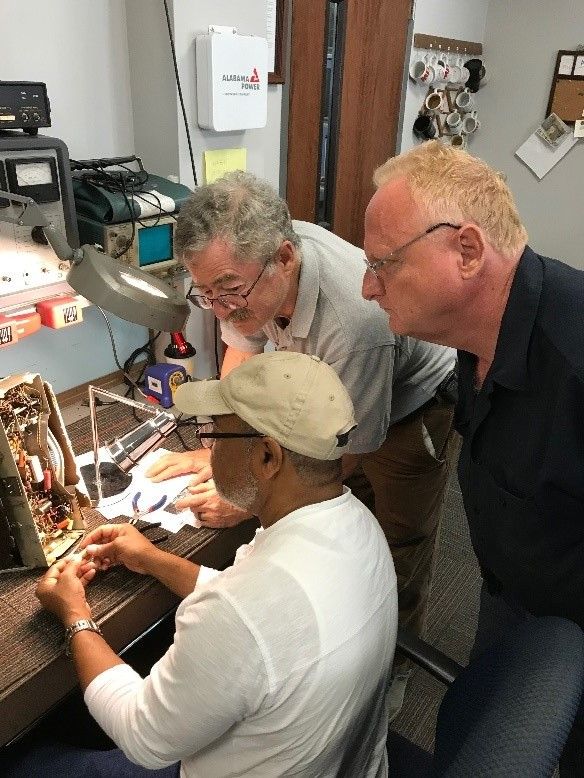
Class members Ron, Richard, and Knox getting ready to change out a capacitor.
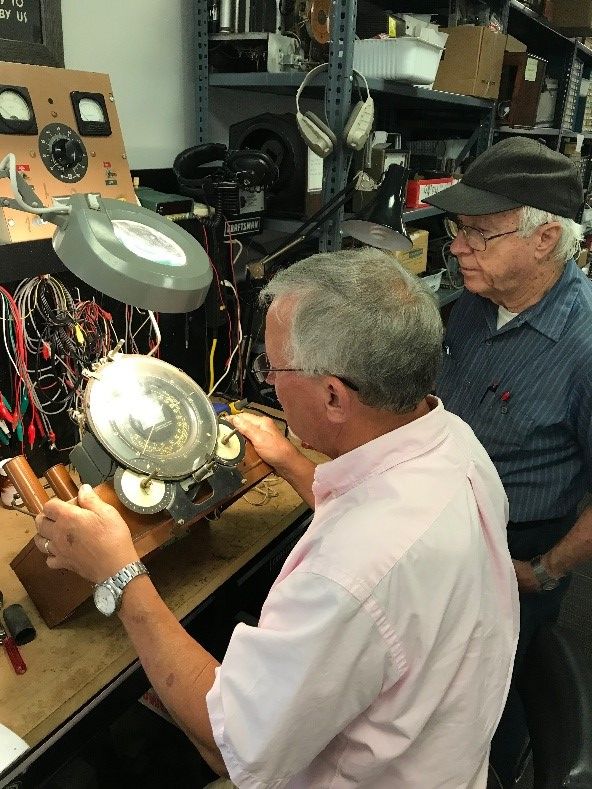
President Dave Johnson looks on as Doc Holiday attacks a client radio
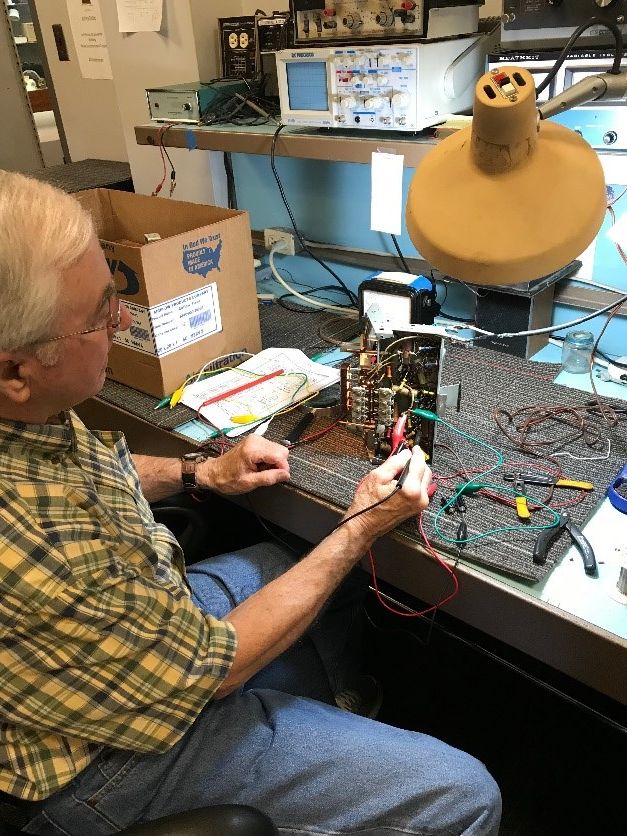
Frank Parker working on his latest project.
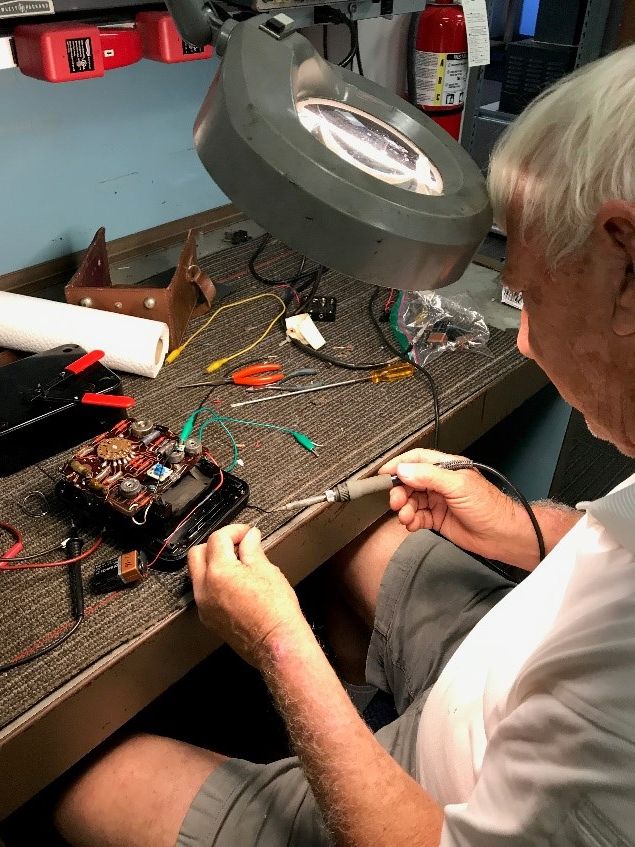
Frank Roberts helping out, repairing a Simpson 260.
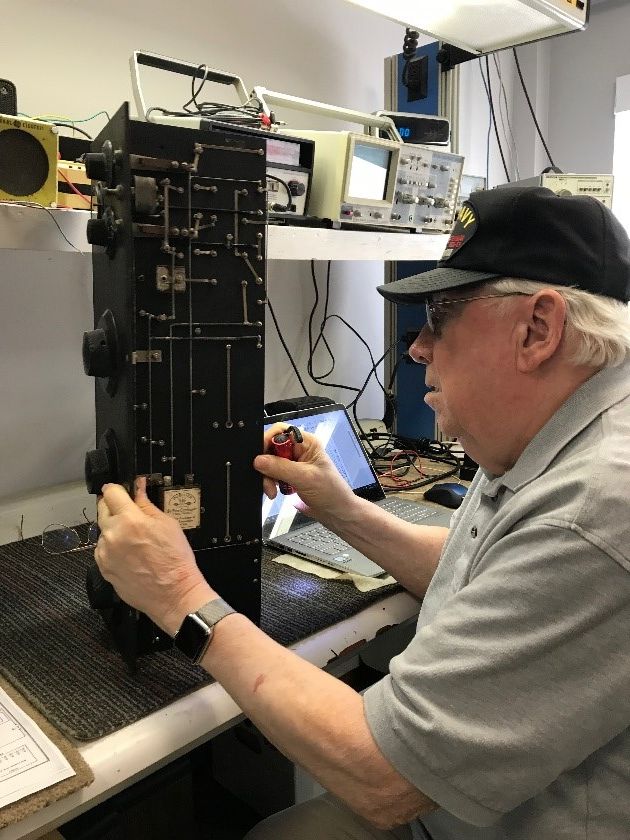
Jim Rogers plotting the course for getting Frank Roberts’ 1923 Gilifanell TRF working. There were a few broken connections in the point to point wiring to resolder. Frank replaced a couple of bad rheostats and the project ready to move to the next step.
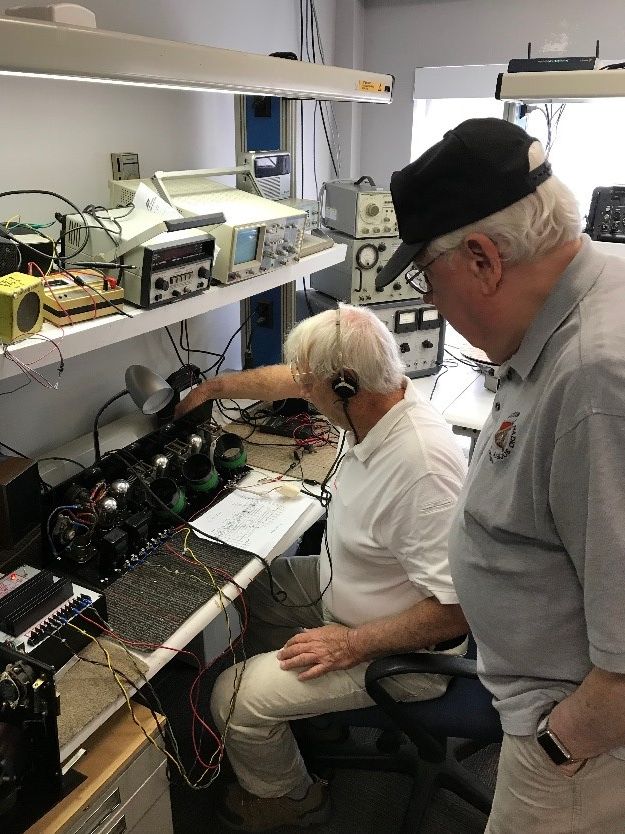
After determining the audio section is working, with Frank Roberts at the helm, going stage by stage from the detector to the antenna connection with the signal generator, verifying each stage and, a few minutes later, tuning in a radio station! Can you say, “Happy Camper?” Now that is what it is all about.

Jimmy Robert’s pondering a tube substitution. “What do you mean Johnny, you don’t have one of these in inventory?”
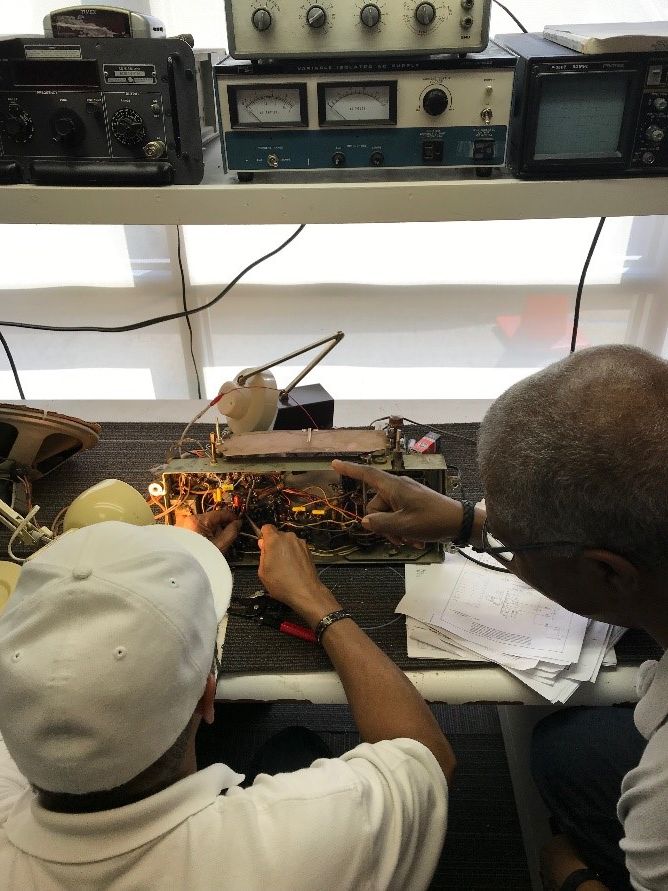
Maurice Hill and Willie Henderson working on a radio.
Saturday Meetings
We meet every Saturday (unless a Holiday weekend) at 9:00 a.m., at the one-story AHRS Shop at the corner of 8th Avenue North and 18th Street, (1801 8th Avenue North, Birmingham, AL 35203). Birmingham, AL 35203). Use the rear (Southeast) entrance.
Tuesday Meetings
The Shop is open on Tuesdays at 9:00 a.m. until around 11:30 a.m. when we go to Marilyn's Deli and Dog for lunch next door. Note that parking can be a problem on Tuesdays, so you may have to find street parking occasionally.
Regular Meetings
We meet on the fourth Monday night of each month, too, at 7:00 p.m. Please come join us!
Free Electronics Classes
One more great benefit from becoming a member of AHRS--free Electronic classes!
Classes are taught the first Saturday of each month (except when something special is taking place, then we agree on what Saturday).
We start from the beginning Ohms Law, inductors, resistor and Capacitors color codes, as well as what each component does within the radio circuits. We also teach how to use test equipment used in the repairing of radios. We teach troubleshooting radio troubles, as well as how to read a radio diagram. There are coil winding classes, and one-on-one repair help. Come join these classes.
Class Schedule for the remainder of 2019
-September 14th Second Saturday
-October 5th First Saturday
-November 16th Third Saturday
-December 7th First Saturday
Membership Dues
Membership dues are $25 a year, payable beginning in January. If you have questions about your dues, you can contact Treasurer Mike Woodruff at 205-823-7204. Dues can be mailed to AHRS at P.O. Box 131418, Birmingham AL 35213.
Website
Be sure and check out our website at https/www.alabamahistoricalradiosociety.org, which has copies of all newsletters from 2006 to the present (click on News), videos, photo galleries, museum, Old Time Radio columns, Projects, Reading Rooms, Archives, and Contact Information
Officers
President – Dave Johnson
(205) 999—7178
johnelecco@charter.net
Vice President – Steven Westbrook
205-305-0679
spwestbro@bellsouth.net
Recording Secretary – Dee Haynes
205-841-4360
k4hfx1@charter.net
Treasurer – Mike Woodruff
205-823-7204
woodruff_michael@hotmail.com
Joe Minor, member and Instructor
205-913-1260
k4joe1@gmail.com
Website – David Lake
dave2008@gmail.com
Web Address:
http://alhrs.org
E-mail Address:
ahrs2000@gmail.com
Newsletter – Jim Rogers
rogers9466@charter.net